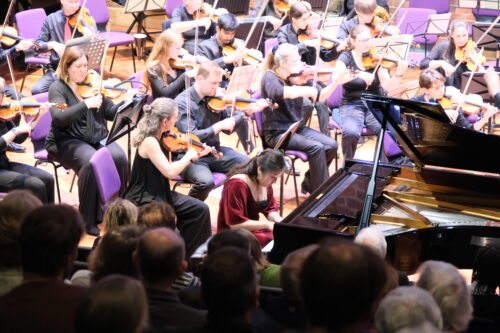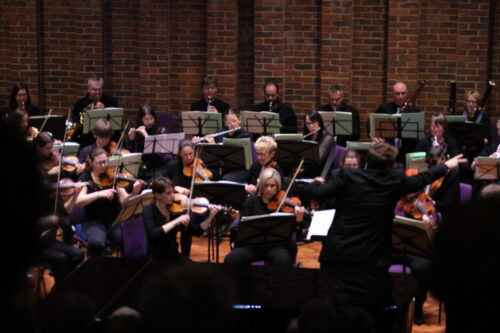 United Kingdom Shostakovich: Jinah Shim, Keelan Carew, Paul Ingram (piano), Mark Cox (trumpet), Austin Lam (cello), Orchestra / Craig Lawton and Paul Ingram (conductors). Turner Sims Concert Hall, Southampton, 2.3.2025. (CK)
United Kingdom Shostakovich: Jinah Shim, Keelan Carew, Paul Ingram (piano), Mark Cox (trumpet), Austin Lam (cello), Orchestra / Craig Lawton and Paul Ingram (conductors). Turner Sims Concert Hall, Southampton, 2.3.2025. (CK)

Shostakovich – October, Op.131; Piano Concerto No.1, Op.35; Symphony No.5, Op.47
Concertino for Two Pianos, Op.94; Overture on Russian and Kirghiz Folk Themes, Op.114; Cello Concerto No.1, Op.107; Symphony No.15, Op.141
Festive Overture, Op.96; Piano Concerto No.2, Op.101; Symphony No.10, Op.93
In 2008 two busy Southampton-based musicians, Paul Ingram and Craig Lawton, staged a musical marathon in aid of Southampton University’s pioneering work in cancer research. They called it the Haydathon; incredibly, over the course of three days, they performed all 104 of Haydn’s symphonies. I understand that seven local orchestras were allotted 12 symphonies each, and the rest were performed – some of them sightread – in workshops.
Amongst others since then have been a Beethovathon (nine symphonies in one day) and, last year, a Tchaikathon. I pale at the thought of the many-headed logistical challenges that such an undertaking must involve. And here they were again, their joint energies undimmed, presenting a feast – a blowout – of one of the twentieth century’s most intimidating musical giants: the Shostakovathon, curated by Paul, in aid of the University’s Centre for Cancer Immunology, opened in 2018.
There was a 45-minute concert for families in the morning, which I was unable to get to (I would like to have heard them play Tahiti Trot). Three full-scale concerts, at lunchtime, in the afternoon and in the evening, presented a sensible and satisfying sequence of symphonies – the Fifth, Tenth and Fifteenth – along with three concertos, two overtures, a concertino for two pianos and Shostakovich’s only tone poem. Of the ten substantial pieces played, three were entirely new to me: these guys don’t play safe.
They had managed to assemble, coordinate and rehearse an orchestral body totalling thirty wind and brass players, six percussionists, two grand pianos, a harp and celesta, and a string body not far short of fifty, securely anchored by nine cellos and five double basses. They crowded the Turner Sims stage – designed for solo recitals, chamber music and small orchestras – almost to overflowing; and what a sound they made! It wasn’t just a matter of volume – though some of the tutti approached the threshold of pain – but the sheer vividness of the individual and collective playing was as intense, as immersive as Shostakovich surely intended.
This was an ad hoc, largely amateur collection of players, not an orchestra of professionals used to playing with each other: but no allowances needed to be made – the occasional cracked note or less than perfect intonation were as nothing compared to this band’s fiery individual and corporate conviction. Many of these players were veterans of the Ingram/Lawton marathons, some from the very start, and it showed.
The day has left a host of sonic impressions. How many times did we hear a woodwind solo – jaunty, grotesque, mournful or desolate – vividly and characterfully taken, or the whole woodwind section in a sombre chant, or skirling like a demented aviary? How many times did the orchestra’s leader tug at our feelings with a tender or quirky violin solo?

Paul and Craig shared the conducting between them, manning timpani or percussion when off podium duty. In the first concert Shostakovich’s late tone poem October – new to me – made a stirring start under Craig’s vigorous direction, its stern heroism reminiscent of the Eleventh Symphony, featuring busy percussion and, climactically, a deafening phalanx of heavy brass. Paul took over for the Piano Concerto No.1; British-Korean pianist Jinah Shim made a splendid soloist, stylish, mercurial and very much alive to the work’s parodic elements, with Mark Cox’s bright, spiky trumpet providing a dazzling foil. The string playing towards the end of the Lento was particularly lovely.
Craig ended the first concert with a thrilling performance of the Symphony No.5, driving the first movement to its cataclysmic apex with unstoppable energy; the strings covered themselves with glory, the violins achieving that searing intensity that the music demands. The Mahlerian Allegretto brought (among much else) an agile bassoon, a stylish solo violin and a magnificently assertive xylophone; the climax of the profound Largo was blindingly intense, and the finale set off like a runaway train – I particularly remember Mark Cox’s trumpet riding high over a maelstrom of strings, a lovely horn solo in the central section, and the low growl of the horns as they launched the music’s ascent towards its final (and perhaps hollow) triumph. It was a performance that took no prisoners: on the podium Craig must have shed a few pounds.
The second concert brought even greater variety, beginning with two ten-minute works that I had not previously heard: a lively Concertino for Two Pianos, deftly played by Jinah Shim and Paul Ingram – she mainly in the treble clef, he in the bass; and the Overture on Russian and Kirghiz Folk Themes, another late work that belies the perception of the composer’s twilight years as ones of unrelieved and deepening gloom. It is a wonderfully ebullient and life-affirming work that I cannot wait to hear again. This substantial first half ended with a brilliant performance of the Cello Concerto No.1: Hong Kong-born Austin Lam’s account of the solo part was nothing short of sensational, as the prolonged ovation at the end clearly demonstrated. He was given first-rate support by the orchestra: special mention for the first horn, almost an obbligato instrument in the concerto’s early stages.
The performance of the Symphony No.15 after the interval was special. I made more notes – far more – than I did on any other of the day’s performances: partly, no doubt, because I know it less well, but there was more to it than that. It is music that seems uneasy with itself, that wears various masks, music that we are sometimes unsure how to decode. After the toyshop Allegretto, in conductor Paul Ingram’s hands the extended slow movement generated inexorable power, from its grim brass chorale and its solo cello rising effortfully from the depths to sing its mournful song, taken up by other instruments, to its sudden eruption into a full-blown funeral march and its long, ghostly retreat into silence. At times we seemed close to the bleak tundra of the late string quartets.
The finale, with its lostness, its inability to cohere, its shreds of Wagner and of Shostakovich’s own music, seems to have nowhere to go. It leaves a disturbing impression that partially aligns it with another great and unsettling final symphony – Mahler’s Ninth. Or so this magnificent performance made me feel. From a whole constellation of solo contributions I must mention the principal cello, the first trombone, the ticking percussion: for me, though, the orchestra’s leader was the true heroine of the performance.
The third and final concert began with a fizzing (and very loud) performance of the Festive Overture, under Craig’s irrepressible direction. Is this the nearest Soviet Russia got to a Pomp and Circumstance March? Then in the hands of pianist Keelan Carew the opening Allegro of the Piano Concerto No.2 was enormous fun, the soloist clearly enjoying every bar, with alert and vividly pointed playing from the orchestra – especially those slashing sforzati that punctuate the piano’s merry progress. Carew showed a charming lightness of touch in the Andante, and the finale was irresistibly effervescent – Carew was grinning from ear to ear as he rattled off the final bars, and he was rewarded with the biggest cheer of the day.
The Tenth Symphony, conducted by Paul Ingram (Craig on timpani), made a fine conclusion to the concert and to the day. From the early stirrings of strings in the dark and the solo clarinet (who bore, eloquently, much of the expressive burden in the first movement’s early stages), the music built to a huge tutti, horns and woodwind at full tilt. The first flute introduced the tense, twisting motif which becomes the means of building the music towards its terrifying climax, with piercing sounds from the woodwind choir and magnificent horns. Duetting piccolos caught the ear before the close.
The brief, savage Scherzo brought playing of real punch, with four skirling clarinets and devastating precision from the percussion. The intriguing third movement featured wonderfully disciplined playing from the strings, a cor anglais cutting through the texture and a splendidly stentorian horn. Very understandably there were a few signs of tiredness in the finale, but the orchestra rose magnificently from the plaintive opening (plaudits to the oboe, and later the clarinet) to its jubilant conclusion. The first crashing in of the DSCH motif was huge, and the momentum as the music drove through to the final bars was thrilling.
A day of quite stupefying music-making; it sounds feebly inadequate to say Thank You to Paul, Craig and all the soloists and players. Paul, evidently not Shostakoviched-out, will conduct the toughest nut of all – the massive Fourth Symphony – in Romsey Abbey on 19 July. After that, I wonder whether he and Craig are already planning their next musical marathon.
Chris Kettle
